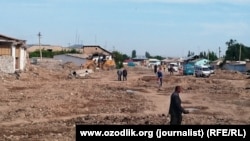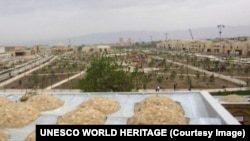In its haste to build a national identity and squeeze more tourism income out of its ancient past, Uzbekistan may have killed the goose that lays the golden eggs in the ancient southeastern city of Shahrisabz.
A state plan aimed at developing tourism has led to the bulldozing of a two-kilometer, 70-hectare swath through the heart of Shahrisabz's medieval residential quarters -- an area that is listed as a UNESCO World Heritage site.
Now the city risks losing its coveted status, as the UN agency that promotes cultural awareness and heritage preservation mulls how to prevent further damage.
Uzbekistan's government ordered the work in Shahrisabz to begin in 2014, under the now deceased President Islam Karimov. Two traditional "mahalla" districts on the UNESCO World Heritage list were replaced with a broad boulevard, a parking lot, and a long plaza described by the UN agency as a "modern theme park with tourist kiosks."
Since Uzbekistan's independence in 1991, the former Soviet state has drawn on history to build its national identity. The theme of the park criticized by UNESCO is Tamerlane, the 14th century Central Asian ruler and founder of the Timurid dynasty whose statue has towered over the area since 1996, when it was erected by Karimov's government.
Tamerlane was born near Shahrisabz and built the city's oldest remaining monuments -- the Oksaroi Palace gate towers and the Dorus Saodat (Seat of Power and Might) mausoleum that contains the tomb of Tamerlane's eldest son, Jahangir.
Both of those World Heritage monuments also are within the modern park -- which celebrates Tamerlane as a national icon.
Clearing away Shahrisabz's medieval UNESCO-listed neighborhoods means pedestrians in the park now have an unobstructed view of Tamerlane's massive statue from more than a kilometer away.
Plans to build a modern tourist hotel beside Shahrisabz's protected monuments were put on hold in July 2016 after UNESCO officials intervened and asked Tashkent to stop the ongoing development.
But the damage had already been done. Networks of old streets -- with traditional houses laid out around a courtyard and veranda -- had been demolished to make way for the development.
Ancient water-management systems and green zones that should have been protected by their UNESCO status were also obliterated.
Worth Its Weight In Gold
With the city's contributions to world culture listed as "endangered," UNESCO is currently considering whether to revoke Shahrisabz's World Heritage status, which should be a kind of goose that lays golden eggs for local tourism.
Feng Jing, head of the Asia-Pacific unit of UNESCO's World Heritage Center, says a key issue is whether "overdevelopment of the tourism sector" has destroyed Shahrisabz's "outstanding universal value."
UNESCO monitors already have reported that the "authenticity and integrity" of the city's historic center appear to have been "irreversibly compromised."
"This tourism development project happened without a proper heritage impact assessment," Jing told RFE/RL. "In that context, the historical appearance of the historical center has been altered."
Jing explained that Shahrisabz's historic city center was inscribed in 2000 on UNESCO's World Heritage list "as a medieval town for its type of urban planning."
UNESCO experts in 2000 described its central structure as "similar to that of Samarkand and Bukhara."
They also compared Shahrisabz's monuments and "traditional period houses" to "the other capitals of the Timurid empire" -- Samarkand and Herat.
"This was a traditional medieval townscape -- these traditional mahallas within the center of the historic city -- where the [tourism development] project has been carried out," Jing lamented.
Out of seven mahallas, Jing said, two in the historical center have been completely demolished.
He said UNESCO hopes that with the development project put on hold, the government will take additional steps that could save the remaining mahallas.
Jing headed UNESCO monitoring teams that visited Shahrisabz in March and December 2016.
Those monitors are preparing a report based on their December visit that be will presented to UNESCO's World Heritage Committee on May 19.
The recommendations will heavily influence a July vote on Shahrisabz's status when the committee has its annual meeting in Krakow.
Committee members also must consider whether revoking Shahrisabz's World Heritage status might lead to further destruction of its remaining cultural treasures.
"This is a World Heritage site and it has the particular requirements in the framework of the World Heritage Convention," Jing explained. "In terms of protecting the site's outstanding universal value, we are in contact with the responsible authorities -- the state party -- to verify all the information received and also to check the extent of the whole damage or threat to the site's outstanding universal value."
Other issues the World Heritage Committee will consider is the government's progress on UNESCO's urgent recommendations.
For example, laws on the protection of World Heritage monuments must be reinforced with enforcement clauses to prevent a repeat of the government decree for tourism development in Shahrisabz. A special agency for protecting and managing Shahrisabz's World Heritage sites must be created, adequately staffed, and financed. And steps must be taken toward establishing a state-run scientific center for heritage conservation.
Finally, "all forms of traditional knowledge and management" for mahallas must be revitalized for heritage protection, according to the UN agency.
Grim Prospects
One historic preservationist in Uzbekistan's Culture and Sports Ministry said prospects for Shahrisabz's World Heritage status are not good.
The ministry official, who spoke to RFE/RL on condition of anonymity, said Uzbekistan's government already has received "two strikes" from UNESCO after the visits by Jing's monitors.
He said the UNESCO experts were stunned by the "irreversible changes" wrought from 2014 to 2016 by the government's development project.
The destruction of Shahrisabz's medieval residential neighborhoods wasn't the only damage.
UNESCO monitors say monuments from the 14th and 15th centuries were hastily renovated "using inappropriate, nonauthentic, and irreversible restoration materials" -- and without following "international conservation" practices.
They say centuries-old brickwork was permanently scarred by cleaners who used grinding tools to speed the work.
Power grinders were used on the 14th century Dorus Saodat complex, medieval baths, the 15th century Kok Gumbaz Mosque, and the 18th-century Chorsu bazaar.
Meanwhile, the UNESCO monitors reported that domes were added to the Kok Gumbaz Mosque and other nearby buildings without adequate research on the authenticity of the designs.
Akmal Rizaev, a Tashkent-based political analyst, said Shahrisabz's protected buildings now look like "pseudo monuments" from the animated Disney film Aladdin.
Uzbekistan's government claims it carried out required historical and archaeological research before rebuilding portions of Shahrisabz's ancient defensive walls.
But UNESCO says it never received responses to its requests for evidence from the alleged archaeological studies -- raising serious doubts about the authenticity of the reconstructed city walls.
Members of Uzbekistan's Union of Architects have told RFE/RL that Shahrisabz's historic center was destroyed because it was left in the hands of "businessmen and contractors" with ties to Karimov's government rather than heritage preservationists.
"Demolition works cost even more than construction activities in this country," said one architect, who insisted on anonymity. "If possible, all construction and renovation work in Uzbekistan's historic cities should be suspended indefinitely."
But that seems unlikely.
Uzbek President Shavkat Miriyaev, who came to power after Karimov's death was announced in September, has vowed to launch a massive push to "develop tourism."
Issa Torres -- an independent expert on sustainable tourism and the conservation of Central Asia's Silk Road World Heritage sites -- told RFE/RL the fate of Shahrisabz provides lessons for future tourism developers.
Torres said development planners in Uzbekistan should take a "holistic approach" and "see the whole picture."
"When a tourist visits a place, he or she doesn't want to visit an isolated monument or historic building," Torres explained. "The holistic experience includes transportation to the place, walking through the streets, feeling the atmosphere, talking to the locals, understanding their culture, eating their dishes, or buying local products."












